Ban Gioc Waterfall is the largest and most beautiful natural waterfall in Southeast Asia, ready to captivate anyone who comes here for the first time. If you plan to visit here but wonder about what to eat, what to play, or where to go, let's Ban Gioc waterfall travel review help you.
Brief introduction of Ban Gioc waterfall
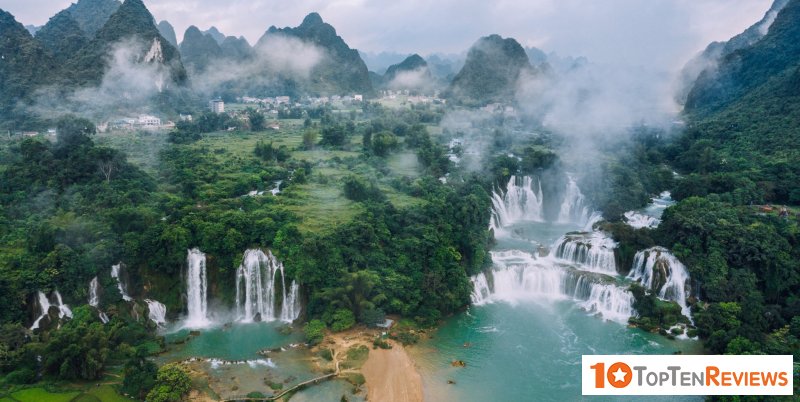
Ban Gioc Waterfall is probably a name no longer strange to any tourist with its enchanting beauty. This place is the largest natural waterfall in Southeast Asia and is ranked at the top of the most beautiful paradises in the world. The waterfall is located between Vietnam - China border, divided into the main waterfall and secondary waterfall, separated by landmark 53 according to the French - Thanh Convention from 1887. From the bottom of the waterfall, the left and western half of the waterfall belong to Vietnam's sovereignty in Dam Thuy commune, Trung Khanh district, Cao Bang province. The eastern half of the waterfall on the right belongs to China's sovereignty at Dai Tan district, Sung Ta city. Thus, the secondary waterfall is entirely Vietnamese and divides the main waterfall in half. When coming here, the highlight attracting visitors' attention is a large tree-covered mound in the middle of the main waterfall, which splits the river into three streams. Coming here on sunny days, visitors will be highly interested in the rainbow of water created by the steam ejected under the color of the sun.
The suitable time to visit Ban Gioc waterfall
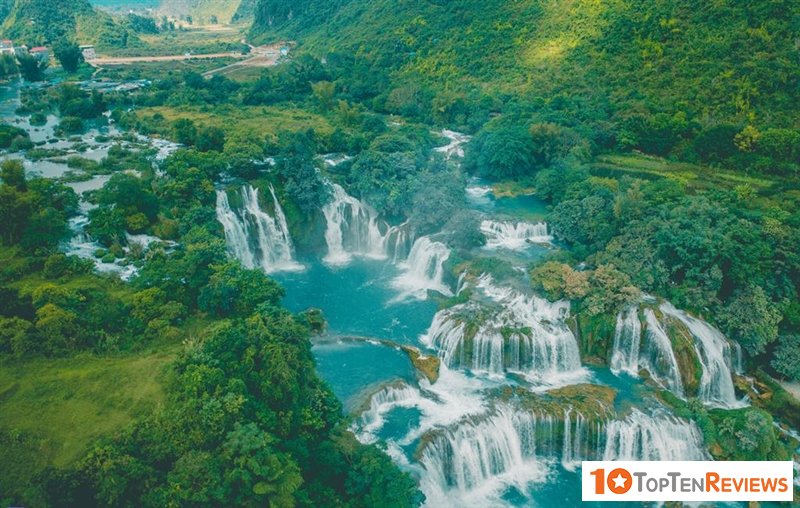
Rainy season in Ban Gioc Waterfall, Cao Bang, Vietnam
It starts in April and ends in September every year. This season is dominated by the southeast monsoon and is influenced by a small portion of the southwest monsoon and northeast monsoon. The average temperature in months between seasons varies between 5 – 6℃. The rainy season average rainfall is 200 – 250mm. The average temperature of the rainy season is 20 – 24℃ and the average humidity is 80% – 90%.
Dry season in Ban Gioc Waterfall, Cao Bang, Vietnam
This season lasts from October last year to March next year. This season, the climate is temperate, cold or foggy. Northeast winter winds are often blown to dry and cold. The cold months usually last from December to February. The average dry season rainfall is 20-40mm, while the lowest is 10 – 20mm. The average dry season is 8 – 15℃ and the average monthly humidity is 70% – 80%.
Perhaps there is no need to worry about traveling to Ban Gioc waterfall because this place is always beautiful; each season puts on its unmistakable beauty. The climate here has two distinct seasons: the rainy season and the dry season. Rainy season: starting from June to September, this is the time when the waterfall brings in its most majestic and intense beauty. The waterfall flows strongly, the white foam clears the sky, making visitors feel like Clouds in the sky are gathering in the rain. Visitors coming here sometimes face a little more obstacles than dry colors, but its majestic beauty will captivate any visitor. Dry season: lasting from October to May next year, Ban Gioc waterfall at this time has the opposite beauty of the dry season, an ethereal, gentle but a bit haughty beauty. The cool blue water combined with the color of ripe rice at the foot of the waterfall creates a highly romantic scene, making you want to immerse yourself in it. However, according to most tourists' Ban Gioc waterfall tourism experience, the best time to come here in August. The weather at this time is delightful, and the tourist activities to explore are also more exciting.
Ban Gioc Waterfall tourist attractions
Nguom Ngao Cave
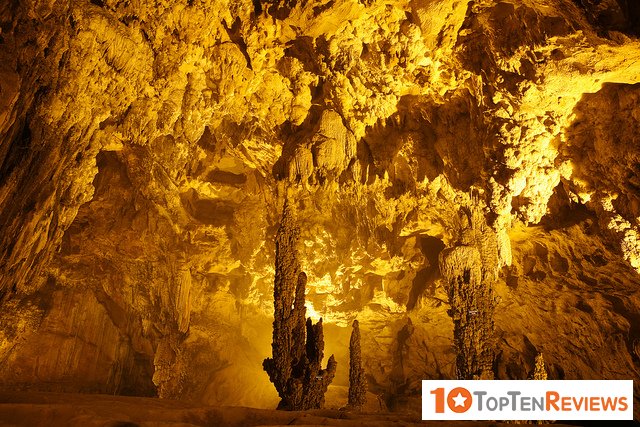
This place is one of the famous destinations mentioned first in the journey to visit Ban Gioc waterfall. Sanskrit colonial cave in Gun village, Dam Thuy commune, Trung Khanh district, Cao Bang. In Tay language, "Nguom" means "cave," "Ngao" means "tiger," "Nguom Ngao" means tiger cave. The cave has more than 2000m, divided into three main areas: the Four Pillars of Heaven, the central area, and the treasure area. The cave has a fantastic wild beauty created by layers of brilliant, golden stalactites. Colorful stalactites seem to grow from the bottom up, from the high stone arches hanging down, with many fancy shapes reflecting shimmering.
Pac Po Cave
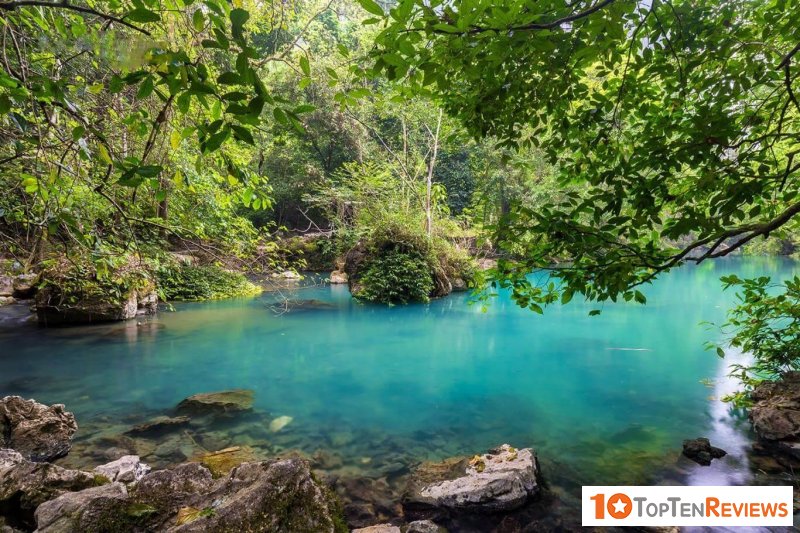
Pac Po Cave appears on the side of a jagged rocky mountain. This cave is a historical landmark that attracts tourists to Ban Gioc. In front of the cave has a small stream that Uncle Ho named Lenin stream. Looking down from the cave, visitors will see his inscription: "February 8, 1941". This landmark records the day Uncle came here to live and do revolutionary activities. The crystal-clear Lenin stream, sometimes mixed with clouds in the sky and deep green mountains, will surely captivate any visitor. Ho Thang Hen Located at an altitude of thousands of meters above sea level, Lake Thang Hen is one of the most beautiful lakes in the Tra Linh mountainous region. The lake is in the middle of a mountainous area with green color, besides the craggy cliffs imprinted on the lake surface with eye-catching shapes. Thang Ne lake is diamond-shaped, winding along the reefs, from 100-300m wide, up to 1000m long. When you come here, you will hear stories about this lake. Every ten years, the lake suddenly runs out of water, and after only a few days, the water rises again. Perhaps the most impressive is the color of the lake water. It always remains jade green while other lakes in the area turn red.
Phat Tich Truc Lam Pagoda Ban Gioc
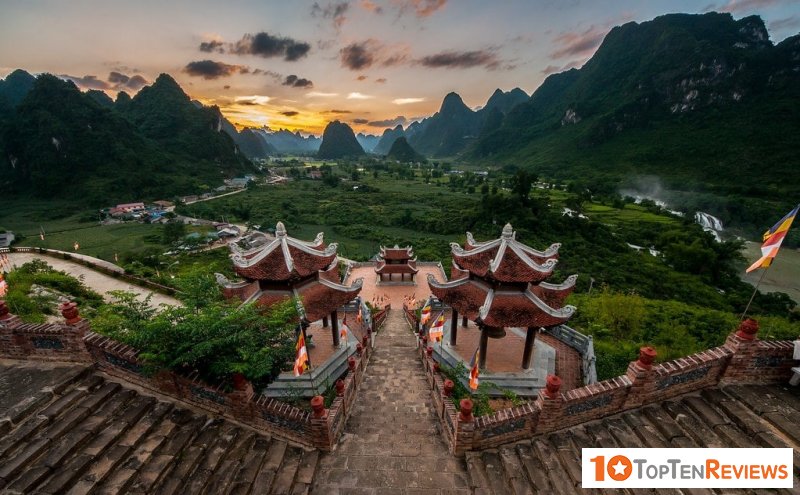
This pagoda is the first temple built on the northern border of the country. The pagoda is away 500m from Ban Gioc waterfall, built in the Vietnamese traditional Buddhist architectural style. Temple of hero Nung Tri Cao - a cultural icon of the 11th century in Cao Bang. The items of the pagoda are Tam Quan pagoda, Bodhisattva statue, Tam Bao, Ancestral house.
What to eat when traveling to Ban Gioc waterfall?
Roasted duck
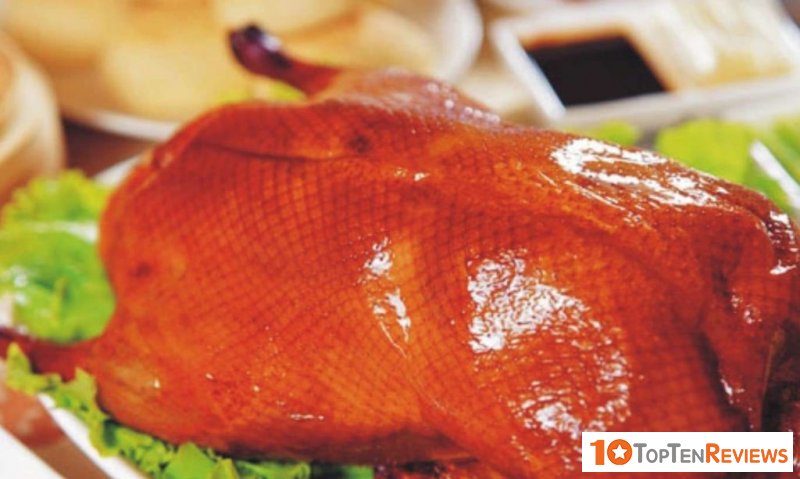
This dish is very familiar in the lowlands, but did you know that this is a specialty of Cao Bang province that anyone who has tried it must have a good compliment. Ducks are carefully selected. They must be grass ducks with firm meat and bright feathers, marinated with seven typical flavors to make Cao Bang duck delicious. Cooked meat is sweet, soft, not crispy, not chewy. Biting slowly, you will feel the fat and sweet taste of meat and honey as if it melts the taste.
Khao cake (Banh Khao)
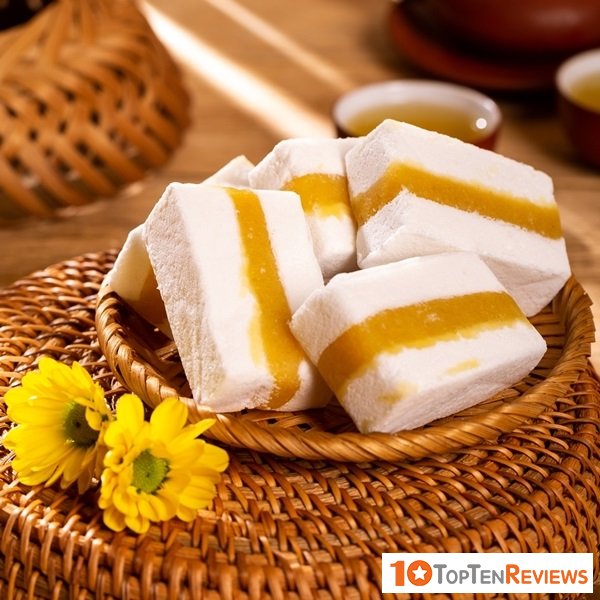
Banh Khao is an indispensable dish on the ancestral altar of ethnic minorities in Cao Bang during Tet. The job of making cakes requires skillful and elaborate hands. After washing Glutinous rice, it is dried and then roasted, then finely ground, ground overnight to make the dough soft and chewy. When the cake is made, it is poured into king paper, crossed into four folded triangles, and glued together. This signature cake is sure to make you fall in love! Sticky rice Traveling to Ban Gioc waterfall without trying sticky rice filling will make you regret it. Delicious moist rice fillings must be selected from ripe and fresh fillers, then soaked in warm water, mixed with cooked sticky rice. Sticky rice, when cooked, has a pinkish purple color that looks highly eye-catching. Cao Bang filling is also processed into strange and attractive snacks such as tofu used in fish stock, tofu sauce, which is also very delicious.
How To Get To Ban Gioc Waterfall, Cao Bang, Vietnam
Getting to Ban Gioc Waterfall by shuttle bus from Hanoi
Ban Gioc waterfall is 90km east of Cao Bang (see map). The easiest and most enjoyable way to reach Ban Gioc is by motorbike. If you don’t already have one, motorbikes are available for rent from some hotels and guest houses in Cao Bang for around 200,000vnd ($10) per day. Alternatively, many accommodations in Cao Bang can arrange a day trip to the falls by hired car with a driver. Another option is to take public transportation: small local buses run from Cao Bang to Ban Gioc and back again several times each day. Ask the staff at your accommodation for more information.
Getting to Cao Bang from Hanoi is pretty straightforward: Either take a bus (including comfortable, two-level sleeper buses) from Hanoi’s My Dinh Bus Station (8 hours) or, if you have your own wheels, take Highway QL3 (which is in excellent condition for most of the way and passes great scenery) from Hanoi to Cao Bang (280km). From Cao Bang to the falls stay on Highway QL3 east via the scenic Ma Phuc Pass to Quang Uyen, then turn left (due north) on Road DT206, which veers east at the town of Trung Khanh before reaching Ban Gioc waterfall. Bear in mind that, if you plan to continue riding beyond Ban Gioc waterfall and along the Chinese border on roads DT206 and DT207, these roads are in pretty bad condition and should be avoided for the time being, unless you are an experienced rider and have a bike that is suitable for off-roading.
Recommended shuttle bus companies
Hung Thanh
- Route: My Dinh Station, Luong Yen Station – Cao Bang Station
- Price: VND 200,000/ticket
- Departs hours: 9:50 – 18:00 – 19:30 (My Dinh Station); 9:00 – 19:30 – 20:00 (Luong Yen Station)
- Phone: (+84) 72 222 694
Ngoc Ha
- Route: My Dinh station – Cao Bang Station
- Price: VND 170,000/ticket
- Departs hour: 11:30 (My Dinh station)
- Phone: (+84) 12 577 004
Khanh Hoan
- Route: My Dinh Station – Cao Bang Station
- Price: VND 200,000/ticket
- Depart hour: 19:00 (My Dinh station)
- Phone: (+84) 15 660 062
Luong Sung
- Route: My Dinh Station – Cao Bang Station
- Price: VND 170,000/ticket
- Depart hour: 11:30 (My Dinh Station)
- Phone: (+84) 12 455 915
Hien Loi
- Route: My Dinh Station – Cao Bang Station
- Price: VND 200,000/ticket
- Depart hour: 10:00 (My Dinh Station)
- Phone: (+84) 15 046 784
Thanh Ly
- Route: My Dinh Station – Cao Bang Station
- Price: VND 200,000/ticket
- Depart hour: 10:00 (My Dinh station)
- Phone: (+84) 912 237 252
Mai Luy
- Route: My Dinh Station – Ha Quang – Ta Lung
- Price: VND 200,000/ticket
- Depart hour: 19:00 – 19:30 – 21:00 (My Dinh Station)
- Phone: (+84) 15 377 272
Vinh Dung
- Route: My Dinh Station – Ha Quang – Ta Lung
- Price: VND 200,000/ticket
- Depart hour: 21:30 (My Dinh Station)
- Phone: (+84) 973 755 755
Getting to Ban Gioc Waterfall by motorbike from Hanoi
Traveling by motorbike is a favorite solution enjoyed by young people when getting to Ban Gioc Waterfall. It is the best way to discover, admire the beauty of nature because you can stop, observe and follow the route as you like. The condition is good health, and you should take a friend with you. Before starting the journey, you should check the stability of the motorbike. In the group, there should be someone who knows a bit about motorbike repair techniques. Prepare raincoat, cold food, drinking water.
Recommended motorbike rental stores
Mr. Luong Vuong
- Address: 366 Ngoc Thuy Street, Long Bien District, Hanoi
- Tel: (+84) 966 902 333
Mr. Tu
- Address: 112 Nguyen Van Cu Street, Long Bien District, Hanoi
- Tel: (+84) 942 467 674
Bon Bon Motor
- Address: 246 Ton Duc Thang Street, Dong Da District, Hanoi
- Tel: (+84) 125 5222 555
Hanoi Motor tour
- Address: 22 463 Lane, Doi Can Street, Ba Dinh District, Hanoi
- Tel: (+84) 928 290 000
Phuong Motor
- Address: 5 Hang Thung Street, Hoan Kiem District District, Hanoi
- Tel: (+84) 904 222 445
Mr. Phat
- Address: 687 Bach Dang Street, Hoan Kiem District, Hanoi
- Tel: (+84) 912 310 505
Mr. Chien
- Address: 21 Kim Dong Street, Hoang Mai District, Hanoi
- Tel: (+84) 947 503 883
Where To Stay In Ban Gioc Waterfall, Cao Bang, Vietnam
On the Chinese side of the river there’s a hotel on the hill, but until recently the Vietnamese side hadn’t seen any significant development. However, a new mid-range resort, called Saigon-Ban Gioc (tel: 091 542 4228), has now opened on the road directly opposite the entrance to the falls. It’s quite a big, sprawling complex but not high enough to be an eyesore. Rooms are good, comfortable and OK value for the price ($40-$50). Breakfast (which isn’t very good) is included in the price, and the restaurant/bar serves lots of Vietnamese dishes and some alcohol too. If you get a room on the higher terraces you can just about see the falls from your balcony, hemmed in by forested limestone mountains. Staying here is a good idea if you want to see the falls at dusk or dawn, which is when they look their best and there’s absolutely nobody around.
As well as the Saigon-Ban Gioc Resort, there are a handful of local guest houses (nhà nghỉ in Vietnamese) on either side of the road, between the Nguom Ngao Caves and the waterfall.
- Ha Vuong Hotel (tel: 096 281 1311),
- Phuong Troi Hotel (tel: 0167 4341 831)
- Kieu Thanh Nguyet Guest House (tel: 096 966 1992) are all just west of the falls on Road DT206.
They all offer simple but clean rooms for around 200,000vnd ($10).
